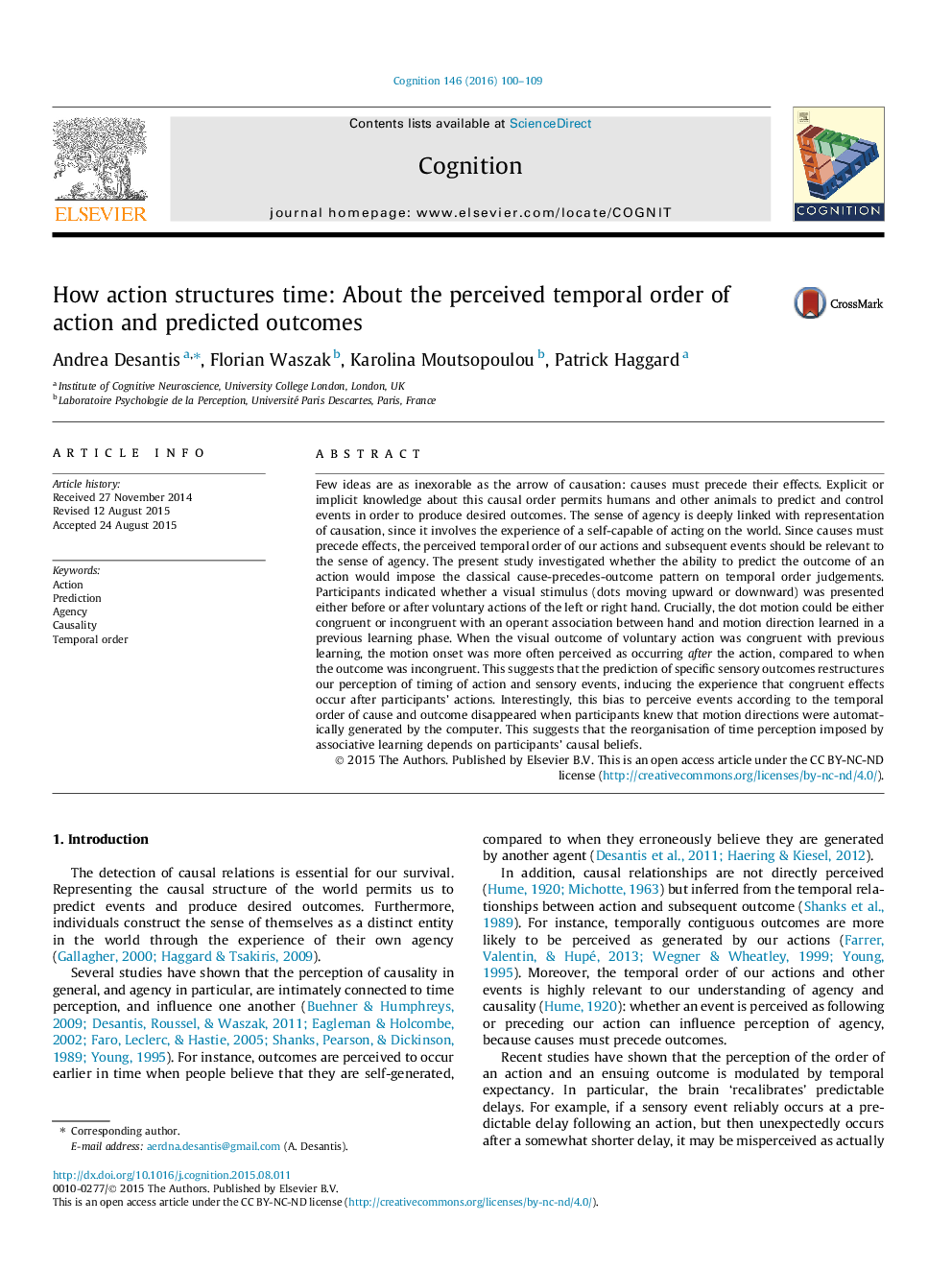| کد مقاله | کد نشریه | سال انتشار | مقاله انگلیسی | نسخه تمام متن |
|---|---|---|---|---|
| 7286385 | 1474121 | 2016 | 10 صفحه PDF | دانلود رایگان |
عنوان انگلیسی مقاله ISI
How action structures time: About the perceived temporal order of action and predicted outcomes
ترجمه فارسی عنوان
چگونگی ساختار سازه زمان: درباره نظم زمانی درک شده عمل و نتایج پیش بینی شده
دانلود مقاله + سفارش ترجمه
دانلود مقاله ISI انگلیسی
رایگان برای ایرانیان
کلمات کلیدی
عمل، پیش بینی، آژانس، علیت، سفارش موقتی
ترجمه چکیده
ایده های اندکی به عنوان روبرو شدن با علت ناخوشایند هستند: علت باید اثرات آنها را پیش برد. دانش صریح یا ضمنی در مورد این قانون علیت اجازه می دهد انسان ها و دیگر حیوانات برای پیش بینی و کنترل حوادث به منظور تولید نتایج مورد نظر. حس آژانس عمیقا با نمایندگی از علیت ارتباط دارد، از آنجا که این تجربه تجربه شخصی قادر به عمل در جهان است. از آنجا که علل باید پیش از اثرات باشند، نظم زمانی درک شده از اقدامات ما و رویدادهای بعدی باید به معنای آژانس باشد. در این تحقیق بررسی شده است که آیا توانایی پیش بینی نتایج عمل، الگوی پیش فرض-نتیجه کلاسیک را در قضاوت های زمانی منظم تحمیل می کند. شرکت کنندگان نشان دادند که آیا یک محرک بصری (نقاط حرکتی به سمت بالا یا پایین) قبل یا بعد از اقدامات داوطلبانه دست چپ یا راست ارائه شده است. مهمتر از همه، حرکت نقطه می تواند هم سازگار باشد یا ناسازگار با ارتباط عملی بین دست و جهت حرکت یاد گرفته در یک مرحله یادگیری قبلی. هنگامی که نتیجه بصری اقدام داوطلبانه با یادگیری قبلی منطبق بود، شروع حرکت اغلب پس از عمل اتفاق می افتد، در مقایسه با زمانی که نتیجه ناهماهنگ بود. این نشان می دهد که پیش بینی نتایج حسی خاص بازسازی ادراک ما از زمان وقوع حوادث حوادث و حوادث را ایجاد می کند و تجربه ای را که اثرات متقابل پس از اقدامات شرکت کنندگان رخ می دهد، بازسازی می کند. جالب توجه است، این تعصب برای درک حوادث با توجه به نظم زمانی علت و نتیجه ناپدید شد زمانی که شرکت کنندگان می دانستند که جهت حرکت به طور خودکار توسط کامپیوتر ساخته شده است. این نشان می دهد که سازماندهی مجدد ادراک زمانی که توسط یادگیری وابسته اعمال می شود بستگی به باورهای عقلانی شرکت کنندگان دارد.
موضوعات مرتبط
علوم زیستی و بیوفناوری
علم عصب شناسی
علوم اعصاب شناختی
چکیده انگلیسی
Few ideas are as inexorable as the arrow of causation: causes must precede their effects. Explicit or implicit knowledge about this causal order permits humans and other animals to predict and control events in order to produce desired outcomes. The sense of agency is deeply linked with representation of causation, since it involves the experience of a self-capable of acting on the world. Since causes must precede effects, the perceived temporal order of our actions and subsequent events should be relevant to the sense of agency. The present study investigated whether the ability to predict the outcome of an action would impose the classical cause-precedes-outcome pattern on temporal order judgements. Participants indicated whether a visual stimulus (dots moving upward or downward) was presented either before or after voluntary actions of the left or right hand. Crucially, the dot motion could be either congruent or incongruent with an operant association between hand and motion direction learned in a previous learning phase. When the visual outcome of voluntary action was congruent with previous learning, the motion onset was more often perceived as occurring after the action, compared to when the outcome was incongruent. This suggests that the prediction of specific sensory outcomes restructures our perception of timing of action and sensory events, inducing the experience that congruent effects occur after participants' actions. Interestingly, this bias to perceive events according to the temporal order of cause and outcome disappeared when participants knew that motion directions were automatically generated by the computer. This suggests that the reorganisation of time perception imposed by associative learning depends on participants' causal beliefs.
ناشر
Database: Elsevier - ScienceDirect (ساینس دایرکت)
Journal: Cognition - Volume 146, January 2016, Pages 100-109
Journal: Cognition - Volume 146, January 2016, Pages 100-109
نویسندگان
Andrea Desantis, Florian Waszak, Karolina Moutsopoulou, Patrick Haggard,
